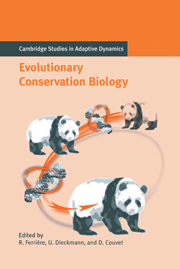Book contents
- Frontmatter
- Contents
- Contributing Authors
- Acknowledgments
- Notational Standards
- 1 Introduction
- Part A Theory of Extinction
- Part B The Pace of Adaptive Responses to Environmental Change
- Part C Genetic and Ecological Bases of Adaptive Responses
- Part D Spatial Structure
- Part E Community Structure
- References
- Index
- The International Institute for Applied Systems Analysis
Part C - Genetic and Ecological Bases of Adaptive Responses
Published online by Cambridge University Press: 15 August 2009
- Frontmatter
- Contents
- Contributing Authors
- Acknowledgments
- Notational Standards
- 1 Introduction
- Part A Theory of Extinction
- Part B The Pace of Adaptive Responses to Environmental Change
- Part C Genetic and Ecological Bases of Adaptive Responses
- Part D Spatial Structure
- Part E Community Structure
- References
- Index
- The International Institute for Applied Systems Analysis
Summary
Introduction to Part C
As Part B shows, there is now strong empirical evidence that a rapid adaptive evolution of life-history traits may occur in response to environmental change in the wild. However, very few empirical studies document the consequences such adaptations have for population dynamics and viability.
Continuing the establishment of a theoretical platform for evolutionary conservation biology, begun in Part A for populations with a static genetic composition, Part C introduces models to assess the extent to which contemporary evolutionary change can contribute to, or hamper, population persistence in the face of environmental threats. For this purpose we need to understand how the different components of the evolutionary process affect population viability under different types of environmental change. This agenda involves a series of more specific questions:
How does genetic variation influence population viability? In populations unaffected by immigration, mutation is the ultimate long-term source of all the genetic variation upon which selection may act. The effect of mutation on population viability is complex. While a large mutation rate implies that new favorable mutations become available relatively quickly, most mutations have primarily deleterious effects. In large populations, selection is expected to remove such deleterious mutations efficiently. In small populations, however, random genetic drift is likely to result in the fixation of deleterious mutations. At the same time, the rates at which beneficial mutations are incorporated decrease with population size.
- Type
- Chapter
- Information
- Evolutionary Conservation Biology , pp. 151 - 154Publisher: Cambridge University PressPrint publication year: 2004

